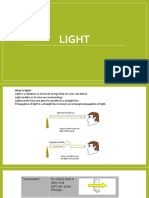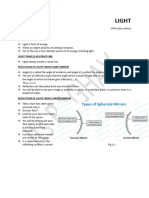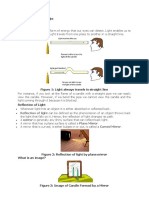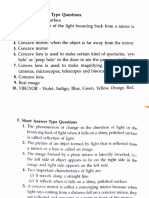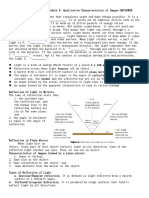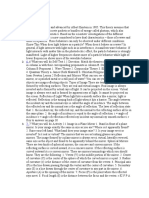0 ratings0% found this document useful (0 votes) 25 views6 pagesSelfstudys Com File
Copyright
© © All Rights Reserved
We take content rights seriously. If you suspect this is your content,
claim it here.
Available Formats
Download as PDF or read online on Scribd
Chapter - 15
Light
Reflection of light
Reflection of light: When light falls on a surface, light bounces off the surface.
This is called reflection.
If itis a shiny surface the image of an object is formed.
Ught ray falling
on the surface. Light ray after reflection.
Tip: Remember the light always travels in a straight line
Type of images
(a) Real image: The image formed which can be obtained on a screen is called
a real image.
(b) Virtual image: The image which cannot be obtained on a screen is called a
virtual image.
Plane mirror: Plane mirror having a shiny surface on which by the reflection of
light the image will be formed of the object placed in front of it.
The properties of the plane mirror:
1) The distance of the image formed by a plane mirror behind the mirror is
equal to the distance of the object from the mirror.
2) The height of the image ina plane mirror is equal to the height of the object.
3) The image formed by a plane mirror is virtual and erect in nature,�Example: The image formed by a plane mirror is at 1m behind the mirror.
What will be the distance (in meters) of the object (i.e., star) from the mirror?
Solution: By the property of the plane mirror:
The distance of the image formed by a plane mirror behind the mirror is equal
to the distance of the object from the mirror
Distance of star from the mirror = Distance of image of the star from the
mirror
Postion of star Image of star
The distance of the image of the star from the mirror = 1m.
Therefore, the distance of the star from the mirror is also 1m.
Lateral Inversion
Lateral Inversion: The phenomenon due to which the left side of the object is
seen on the right side in the image and the right side of the object appears to
be on the left side in the image.�Example: The word ‘AMBULANCE’ is written in the form ofa mirror image on a
vehicle. Why?
Solution: The word ‘AMBULANCE’ is written in a mirror image so that, the
driver in the vehicle going ahead of the ambulance could read it correctly
in his rearview mirror and he would give way to the ambulance so as to allow
the ambulance to reach the hospital as soon as possible. This happens because
of the lateral inversion we observe in a mirror.
Spherical mirrors
Spherical mirrors: The spherical mirrors are curved mirrors, they are of two
types concave mirror and convex mirror.
Concave mirror: When a reflecting surface of a spherical mirror is curved in,
like the interior of a sphere the mirror is called a concave mirror.
SV Tor reflecting surface
Reflecting surface
Concave Mirror
Properties of the concave mirror:
(i) The image formed by the concave mirror is real - inverted usually and
virtual - erect when the object is placed very close to the mirror.
(ii) Concave mirror is converging in nature.
Uses of Concave mirror:�(a) Concave mirrors are used in headlights of vehicles and reflectors of
torches.
(b) Dentist uses a concave mirror to see an enlarged image of the teeth.
(©) Concave mirrors are used as shaving mirrors as these magnify the image
and the image is upright when the mirror is held closed.
Convex mirror: When a reflecting surface of a spherical mirror is curved
outward, like the exterior of a sphere the mirror is called a convex mirror.
Reflecting surface,
Non-reflecting surface
Convex Mirror
Properties of the convex mirror:
(i) The image formed by the convex mirror is virtual, erect and smaller in size.
(ii) Convex mirror is diverging in nature.
Uses of Convex mirror:
(a) Convex mirrors are used in vehicles as the rearview mirror. Because the
image is erect and small in size which increases the field of view.
(b) Convex mirrors are used for securities purposes.
Spherical Lenses
Spherical Lenses:
(a) Convex lens: Lenses which are thicker in the middle than at the edges are
called convex lenses.�Properties of convex lens:
(i) Convex lens forms real and inverted images usually. A virtual and erect
image is formed in the convex mirror in the case when the object is placed
very close to the lens.
(ii) Convex lens is converging in nature.
(b) Concave lens: Lenses which are thinner in the middle than at the edges are
called concave lenses.
Properties of concave lens:
(i) The image formed by a concave lens is virtual and erect.
(ii) Convex lens is diverging in nature.�Uses of Curved lenses:
(a) Lenses are used in spectacles to correct eye defects.
(b) Lenses are used in optical instruments like microscopes, telescopes,
camera, magnifying glasses etc.
Tip: Remember the lens used in magnifying glass is a convex lens.
Example: Given figure shows the path of light through a lens X (imagine there
is a lens instead of the rectangular block as shown in the figure below)
Identify the lens X?
LensXx
Solution: The light rays are diverging in the diagram. Therefore, the lens is a
concave lens as the concave lens is diverging in nature.
Sunlight — White or Coloured?
Sunlight or white light is made up of seven colours called VIBGYOR.
These colours are violet, indigo, blue, green, yellow, orange and red.
we
Prism A
Tip: Rainbow is an example of splitting of white light into its component of
seven colours.

